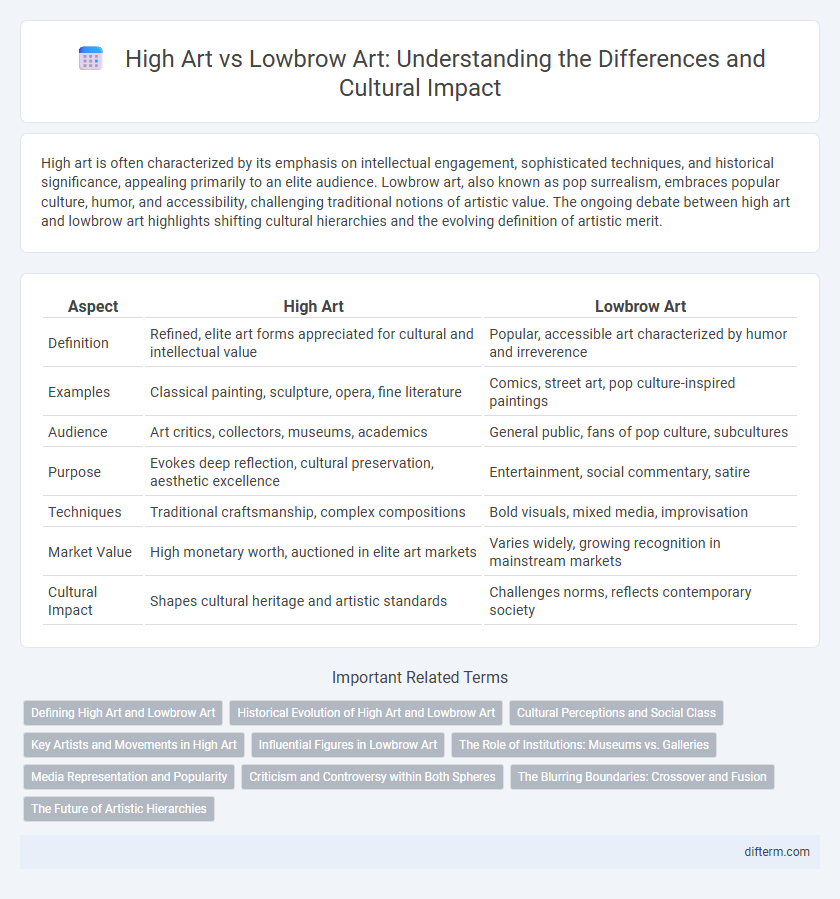High art is often characterized by its emphasis on intellectual engagement, sophisticated techniques, and historical significance, appealing primarily to an elite audience. Lowbrow art, also known as pop surrealism, embraces popular culture, humor, and accessibility, challenging traditional notions of artistic value. The ongoing debate between high art and lowbrow art highlights shifting cultural hierarchies and the evolving definition of artistic merit.
Table of Comparison
| Aspect | High Art | Lowbrow Art |
|---|---|---|
| Definition | Refined, elite art forms appreciated for cultural and intellectual value | Popular, accessible art characterized by humor and irreverence |
| Examples | Classical painting, sculpture, opera, fine literature | Comics, street art, pop culture-inspired paintings |
| Audience | Art critics, collectors, museums, academics | General public, fans of pop culture, subcultures |
| Purpose | Evokes deep reflection, cultural preservation, aesthetic excellence | Entertainment, social commentary, satire |
| Techniques | Traditional craftsmanship, complex compositions | Bold visuals, mixed media, improvisation |
| Market Value | High monetary worth, auctioned in elite art markets | Varies widely, growing recognition in mainstream markets |
| Cultural Impact | Shapes cultural heritage and artistic standards | Challenges norms, reflects contemporary society |
Defining High Art and Lowbrow Art
High art represents classical forms such as fine painting, sculpture, and opera, valued for their intellectual depth, historical significance, and technical mastery. Lowbrow art, often linked to pop culture and street art, embraces humor, satire, and accessible themes that challenge traditional art norms. This distinction reflects broader cultural hierarchies shaping perceptions of artistic value and societal prestige.
Historical Evolution of High Art and Lowbrow Art
High art, traditionally associated with classical forms like painting, sculpture, and opera, has evolved through centuries as a symbol of cultural prestige and intellectual sophistication. Lowbrow art, emerging prominently in the 1970s in California, blends pop culture, street art, and countercultural themes, challenging conventional artistic hierarchies. The historical evolution of both art forms reflects shifting societal values and the democratization of artistic expression.
Cultural Perceptions and Social Class
High art often holds prestige within elite social classes, symbolizing cultural refinement and intellectual achievement, while lowbrow art is associated with popular culture and accessibility among working-class communities. Cultural perceptions frame high art as sophisticated and exclusive, influencing art market values and institutional recognition, whereas lowbrow art embraces subversive themes and challenges traditional aesthetics. This dichotomy reflects broader social class divisions, where artistic preferences reinforce identity and social stratification.
Key Artists and Movements in High Art
High art is characterized by artists such as Leonardo da Vinci, Michelangelo, and Pablo Picasso, whose works define movements like the Renaissance, Baroque, and Cubism. These movements emphasize technical mastery, complex themes, and cultural significance, distinguishing high art from popular or lowbrow art forms. The focus on innovation and influence within art history solidifies the status of high art in galleries and academic discourse.
Influential Figures in Lowbrow Art
Influential figures in lowbrow art include artists like Robert Williams, whose work helped define the movement with its blend of pop culture and underground comics. Mark Ryden, known for his surreal and whimsical imagery, further elevated lowbrow art by bridging fine art and subcultural aesthetics. These artists challenged traditional art hierarchies by embracing accessible themes and vibrant storytelling that resonate with a diverse audience.
The Role of Institutions: Museums vs. Galleries
Museums often establish the authority of high art by curating historically significant and academically vetted works, reinforcing cultural hierarchies through their educational missions and institutional prestige. Galleries, in contrast, play a key role in promoting lowbrow art by offering commercial platforms for emerging, unconventional, and popular artists, fostering accessibility and contemporary relevance. The dynamic between these institutions shapes public perception and market value, influencing the ongoing dialogue between elitism and democratization in the art world.
Media Representation and Popularity
High art often receives extensive media coverage in prestigious galleries and museums, reinforcing its elite status and cultural significance. Lowbrow art thrives in popular media and social platforms, appealing to broader audiences through accessible themes and vibrant imagery. Popularity in media representation shapes public perception, with high art associated with intellectual appreciation and lowbrow art linked to entertainment and mass appeal.
Criticism and Controversy within Both Spheres
High art and lowbrow art often ignite intense debate regarding artistic value and cultural legitimacy, with critics questioning the boundary between refined aesthetics and popular appeal. Controversies arise as high art is scrutinized for elitism and exclusionary practices, while lowbrow art faces dismissal for perceived lack of sophistication and commercialism. This ongoing criticism highlights tensions over authenticity, accessibility, and the evolving definitions of art in contemporary culture.
The Blurring Boundaries: Crossover and Fusion
The blurring boundaries between high art and lowbrow art reflect a dynamic cultural shift where traditional distinctions dissolve through crossover and fusion, enriching contemporary artistic expression. This fusion often features street art, pop culture motifs, and classical techniques intermingling, challenging elitist art norms while expanding audience engagement. Key examples include Jeff Koons blending commercial imagery with fine art and Banksy merging graffiti with political commentary, highlighting the evolving dialogue between aesthetic hierarchies.
The Future of Artistic Hierarchies
High art and lowbrow art have traditionally occupied distinct cultural hierarchies, with high art often associated with elite, institutional validation and lowbrow art linked to popular, accessible expression. Emerging trends reveal a blurring of these boundaries as digital platforms amplify diverse artistic voices, challenging conventional definitions of artistic value and prestige. This democratization of art threatens to redefine future artistic hierarchies, emphasizing cultural relevance and audience engagement over historical elitism.
high art vs lowbrow art Infographic

 difterm.com
difterm.com